U.S. Department of Transportation
Federal Highway Administration
1200 New Jersey Avenue, SE
Washington, DC 20590
202-366-4000
Pavement and shoulder resurfacing and widening infrastructure safety treatments may improve a vehicle's ability to remain on the roadway. This occurs by increasing the paved area for use by a vehicle, providing warning when a vehicle is leaving the driving lane, or improving the friction to reduce hydroplaning and loss of vehicle control.
| Safety Treatment | For more information, visit page | Cost | Frequency of Maintenance (years) | Safety Benefit | Benefit Cost Ratio30 | |||||
|---|---|---|---|---|---|---|---|---|---|---|
| Initial Implementation | Ongoing Maintenance | NCHRP 500 Performance Rating | Crash Modification Factor (CMF) | Lower Volume*, Optimal Conditions*** | Higher Volume**, Optimal Conditions*** | Lower Volume*, Narrower Conditions**** | Higher Volume**, Narrower Conditions**** | |||
| Install a Safety Edge | 86 | $ | - | 20 | P | 0.85-0.92 | 33.4 | 267.2 | 40.9 | 403.2 |
| Install Center Line Rumble Strips | 87 | $ | - | 10 | P | 0.75-0.85 | 21.3 | 170.6 | 26.1 | 257.5 |
| Install Edge Line or Shoulder Rumble Strips | 88 | $ | - | 10 | P | 0.78-0.90 | 58.6 | 469.0 | 71.8 | 707.7 |
| Install Transverse Rumble Strips | 89 | $ | P | 0.76-0.91 | ||||||
| Regrade or Recondition Gravel Lanes | 90 | $-$$ | T | |||||||
| Install Targeted Longitudinal Rumble Strips at Key Locations (Such as on the Outside of Horizontal Curves Only) |
91 | $$-$$$ | T | 0.85 | ||||||
| Install or Maintain a Graded Shoulder | 92 | $$-$$$ | P | 0.52 | ||||||
| Provide Turnout Areas | 93 | $$-$$$ | T | |||||||
| Improve Pavement Friction/Increase Skid Resistance | 94 | $$$$ | - | 10 | P | 0.25-0.60 | 3.3 | 26.7 | 4.1 | 40.3 |
| Add Paved Shoulder | 95 | $$$$$ | $$ | 2 | P | 0.86 | n/a | n/a | 0.5 | 4.5 |
| Widen Existing Travel Lanes by Two Feet or Less per Lane | 96 | $$$$$ | $$$ | 10 | P | 0.95 | n/a | n/a | 0.3 | 2.8 |
| Install Passing or Climbing Lanes | 97 | $$$$$ | $$$ | 10 | P | 0.3 | 2.3 | 0.4 | 3.5 | |
| Increase Shoulder Width | 98 | $$$$$ | P | 0.90-0.97 | ||||||
| Improve Superelevation at Horizontal Curve Locations | 99 | $$$$$ | P | |||||||
Cost: NCHRP 500 Performance rating31 *Lower Volume ≤ 1000 vpd |
||||||||||
When a vehicle leaves the traveled way and encounters a pavement-shoulder drop-off, it can be difficult for the driver to return safely to the roadway. A safety edge is a treatment intended to minimize drop-off-related crashes. With this treatment, the pavement edge is sloped at an angle (30-35 degrees) to make it easier for a driver to safely reenter the roadway after inadvertently driving onto the shoulder. This treatment is designed to be a standard policy for any overlay project.
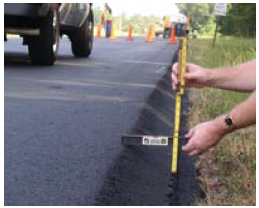
Where to Use: Each State should implement policies and procedures to incorporate the Safety Edge where pavement and non-pavement surfaces interface on all paving and resurfacing projects with surface differentials of 2.5 inches or more. The differentials should be measured from the pavement surface to the adjacent non-pavement surface, accounting for grading along the pavement edge during construction and including existing drop-offs. The Safety Edge is appropriately used at locations where pavement edge drop-offs occur through everyday use, particularly on rural roads with unpaved shoulders.
Note: In general, the Safety Edge is used the entire length of a project, rather than only in locations where a drop-off exists for a short distance.
| Install a Safety Edge - Initial Investment: $2,145 - Cost of Maintenance: n/a - Frequency of Maintenance: 20 years |
Benefit-Cost Ratio | NCHRP 500 Performance Rating | Crash Modification Factor (CMF) |
|---|---|---|---|
| Lower Volume Optimal Conditions | 33.4 | Proven | 0.85-0.92 |
| Higher Volume Optimal Conditions | 267.2 | Proven | 0.85-0.92 |
| Lower Volume Narrower Conditions | 40.9 | Proven | 0.85-0.92 |
| Higher Volume Narrower Conditions | 403.2 | Proven | 0.85-0.92 |
Top Recommended Resources:
1. FHWA, "Proven Safety Countermeasures: Longitudinal Rumble Strips and Stripes on 2-Lane Roads," April 2012. Available at: http://safety.fhwa.dot.gov/provencountermeasures/fhwa_sa_12_008.htm.
2. FHWA, "Promoting the Implementation of Proven Safety Countermeasures," memorandum. January 12, 2012. Available at: http://safety.fhwa.dot.gov/provencountermeasures/pc_memo.htm.
3. FHWA, Roadway Departure Safety: A Manual for Local Rural Road Owners, January 2011. Available at: http://safety.fhwa.dot.gov/local_rural/training/fhwasa1109/fhwasa1109.pdf.
Rumble strips are raised or grooved patterns on the roadway that provide both an audible warning (rumbling sound) and a physical vibration to alert drivers that they are leaving the driving lane. Rumble strips may be installed on the center line of undivided highways, on the roadway shoulder, or on the roadway surface (transverse rumble strips).
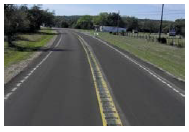
Where to Use: Shoulder milled rumble strips should be used on roads with a history of roadway departure crashes. It is recommended that rumble strips be applied systematically along an entire route instead of only at spot locations. For all rumble strips, pavement condition should be sufficient to accept milled rumble strips.
Rumble strips should be provided on all new rural freeways and on all new rural two-lane highways with travel speeds of 50 mph or greater. In addition, State 3R and 4R policies should consider installation of continuous shoulder rumble strips on all rural freeways and on all rural two-lane highways with travel speeds of 50 mph or above (or as agreed to by the Division and the State) and/or a history of roadway departure crashes, where the remaining shoulder width beyond the rumble strip will be 4 feet or greater, paved or unpaved.
| Install Center Line Rumble Strips - Initial Investment: $5,000 - Cost of Maintenance: n/a - Frequency of Maintenance: 10 years (2 applications) |
Benefit-Cost Ratio | NCHRP 500 Performance Rating | Crash Modification Factor (CMF) |
|---|---|---|---|
| Lower Volume Optimal Conditions | 21.3 | Proven | 0.75-0.85 |
| Higher Volume Optimal Conditions | 170.6 | Proven | 0.75-0.85 |
| Lower Volume Narrower Conditions | 26.1 | Proven | 0.75-0.85 |
| Higher Volume Narrower Conditions | 257.5 | Proven | 0.75-0.85 |
Top Recommended Resources:
1. FHWA, "Proven Safety Countermeasures: Longitudinal Rumble Strips and Stripes on 2-Lane Roads," April 2012. Available at: http://safety.fhwa.dot.gov/provencountermeasures/fhwa_sa_12_008.htm.
2. FHWA, "Promoting the Implementation of Proven Safety Countermeasures," memorandum. January 12, 2012. Available at: http://safety.fhwa.dot.gov/provencountermeasures/pc_memo.htm.
3. FHWA, Roadway Departure Safety: A Manual for Local Rural Road Owners, January 2011. Available at: http://safety.fhwa.dot.gov/local_rural/training/fhwasa1109/fhwasa1109.pdf.
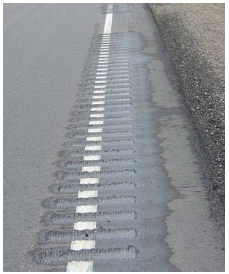
Where to Use: Shoulder milled rumble strips should be used on roads with a history of roadway departure crashes. It is recommended that rumble strips be applied systematically along an entire route instead of only at spot locations. For all rumble strips, pavement condition should be sufficient to accept milled rumble strips.
Rumble strips should be provided on all new rural freeways and on all new rural two-lane highways with travel speeds of 50 mph or greater. In addition, State 3R and 4R policies should consider installation of continuous shoulder rumble strips on all rural freeways and on all rural two-lane highways with travel speeds of 50 mph or above (or as agreed to by the Division and the State) and/or a history of roadway departure crashes, where the remaining shoulder width beyond the rumble strip will be 4 feet or greater, paved or unpaved.
| Install Edge Line or Shoulder Rumble Strips - Initial Investment: $3,000 - Cost of Maintenance: n/a - Frequency of Maintenance: 10 years (2 applications) |
Benefit-Cost Ratio | NCHRP 500 Performance Rating | Crash Modification Factor (CMF) |
|---|---|---|---|
| Lower Volume Optimal Conditions | 58.6 | Proven | 0.78-0.90 |
| Higher Volume Optimal Conditions | 469.0 | Proven | 0.78-0.90 |
| Lower Volume Narrower Conditions | 71.8 | Proven | 0.78-0.90 |
| Higher Volume Narrower Conditions | 707.7 | Proven | 0.78-0.90 |
Top Recommended Resources:
1. FHWA, "Proven Safety Countermeasures: Longitudinal Rumble Strips and Stripes on 2-Lane Roads," April 2012. Available at: http://safety.fhwa.dot.gov/provencountermeasures/fhwa_sa_12_008.htm.
2. FHWA, "Promoting the Implementation of Proven Safety Countermeasures," memorandum. January 12, 2012. Available at: http://safety.fhwa.dot.gov/provencountermeasures/pc_memo.htm.
3. FHWA, Roadway Departure Safety: A Manual for Local Rural Road Owners, January 2011. Available at: http://safety.fhwa.dot.gov/local_rural/training/fhwasa1109/fhwasa1109.pdf.
Rumble strips are raised or grooved patterns on the roadway that provide both an audible warning (rumbling sound) and physical vibration to alert drivers of an upcoming intersection, curve, or other geometry change. Rumble strips may be installed on the center line of undivided highways, on the roadway shoulder, or on the roadway surface (transverse rumble strips).
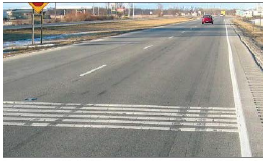
Where to Use: Transverse rumble strips have been used by some agencies to warn drivers in rural areas that they are approaching an intersection, a horizontal curve, or reduced speeds.
| Safety Treatment | Initial Implementation Cost | NCHRP 500 Performance Rating | Crash Modification Factor (CMF) |
|---|---|---|---|
| Install Transverse Rumble Strips | $0 to $5,000 | Proven | 0.76-0.91 |
Top Recommended Resources:
1. FHWA, Low Cost Treatments for Horizontal Curve Safety, December 2006. Available at:http://safety.fhwa.dot.gov/roadway_dept/horicurves/fhwasa07002/.
2. FHWA, "Proven Safety Countermeasures: Longitudinal Rumble Strips and Stripes on 2-Lane Roads," April 2012. Available at: http://safety.fhwa.dot.gov/provencountermeasures/fhwa_sa_12_008.htm.
3. FHWA, "Promoting the Implementation of Proven Safety Countermeasures," memorandum. January 12, 2012. Available at: http://safety.fhwa.dot.gov/provencountermeasures/pc_memo.htm.
4. FHWA, Roadway Departure Safety: A Manual for Local Rural Road Owners, January 2011. Available at: http://safety.fhwa.dot.gov/local_rural/training/fhwasa1109/fhwasa1109.pdf.
Maintaining a proper grade on gravel roads helps to remove rutting, shape the road to allow for proper drainage, smooth the driving surface, and bring the road surface up to bridge approaches or low water crossing approaches. Each of these considerations helps improve safety for those traveling along the route.
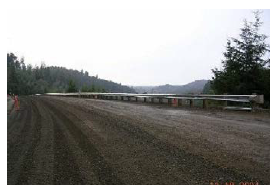
Where to Use: This treatment should be considered as routine maintenance on all unpaved roadways.
| Safety Treatment | Initial Implementation Cost | NCHRP 500 Performance Rating |
|---|---|---|
| Regrade or Recondition Gravel Lanes | $0 to $20,000 | Tried |
Top Recommended Resource:
1. Huntington, G., "Road Geometry, Surface Materials Are Key to Safety on Gravel Roads," Safety Compass 6, No. 2 (2012), 4-5.
Shoulder or edge line milled rumble strips can be used on roads with a history of roadway departure crashes. While it is recommended that rumble strips be applied systematically along an entire route instead of only at spot locations, where appropriate, they can be used on the outside of horizontal curves and the tangents leading to the curves.
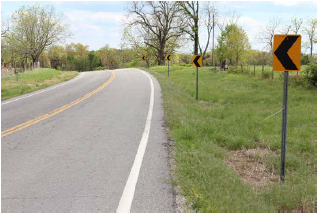
Where to Use: Horizontal curve locations with a high frequency of roadway departure crashes.
| Safety Treatment | Initial Implementation Cost | NCHRP 500 Performance Rating | Crash Modification Factor (CMF) |
|---|---|---|---|
| Install Targeted Longitudinal Rumble Strips at Key Locations (Such as on the Outside of Horizontal Curves Only) | $5,001 to $50,000 | Tried | 0.85 |
Top Recommended Resources:
1. FHWA, Low Cost Treatments for Horizontal Curve Safety, December 2006. Available at:http://safety.fhwa.dot.gov/roadway_dept/horicurves/fhwasa07002/.
2. FHWA, "Proven Safety Countermeasures: Longitudinal Rumble Strips and Stripes on 2-Lane Roads," April 2012. Available at: http://safety.fhwa.dot.gov/provencountermeasures/fhwa_sa_12_008.htm.
Installing an earth or graded shoulder adjacent to the travel lane provides a recovery area for vehicles should they depart the roadway. The shoulder serves as an opportunity for the driver to correct their direction of travel by either re-entering the roadway or serving as a buffer before traversing the sideslope.

Where to Use: This treatment may be used at locations where no shoulders exist and/or where roadway departure crashes frequently occur.
| Safety Treatment | Initial Implementation Cost | NCHRP 500 Performance Rating | Crash Modification Factor (CMF) |
|---|---|---|---|
| Install Targeted Longitudinal Rumble Strips at
Key Locations (Such as on the Outside of Horizontal Curves Only) |
$5,001 to $50,000 | Proven | 0.52 |
Top Recommended Resources:
1. FHWA, Low Cost Treatments for Horizontal Curve Safety, December 2006. Available at:http://safety.fhwa.dot.gov/roadway_dept/horicurves/fhwasa07002/.
Turnout areas are additional pavement beyond the travel way used for slower moving traffic to allow following traffic to pass.

Where to Use: This treatment may be used in low-volume rural locations where farm equipment and other slow moving vehicles are common. Because turnout areas can cause extreme speed differentials, they should not be installed at locations with high traffic volumes.
| Safety Treatment | Initial Implementation Cost | NCHRP 500 Performance Rating |
|---|---|---|
| Provide Turnout Areas | $5,001 to $50,000 | Tried |
Vehicles often leave the road due to lack of friction–especially in wet conditions when water between the tires and pavement could cause hydroplaning. Pavement friction treatments can reduce the number of wet-road crashes by improving friction at specific locations.
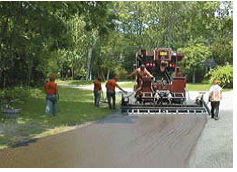
Where to Use: Treatments such as epoxy-based, micro-surface, or chip seal overlays can address spot locations (e.g., a single curve, interchange ramp, bridge, or short roadway section). Friction treatments should be applied at locations with severe slick conditions that could benefit from increased friction.
| Improve Pavement Friction/Increase Skid Resistance - Initial Investment: $53,335 - Cost of Maintenance: n/a - Frequency of Maintenance: 10 years (2 applications) |
Benefit-Cost Ratio | NCHRP 500 Performance Rating | Crash Modification Factor (CMF) |
|---|---|---|---|
| Lower Volume Optimal Conditions | 3.3 | Proven | 0.25-0.60 |
| Higher Volume Optimal Conditions | 26.7 | Proven | 0.25-0.60 |
| Lower Volume Narrower Conditions | 4.1 | Proven | 0.25-0.60 |
| Higher Volume Narrower Conditions | 40.3 | Proven | 0.25-0.60 |
Top Recommended Resource:
1. FHWA, Roadway Departure Safety: A Manual for Local Rural Road Owners, January 2011. Available at: http://safety.fhwa.dot.gov/local_rural/training/fhwasa1109/fhwasa1109.pdf.
The addition of a paved shoulder to an existing road can help to reduce run-off-road crashes. Benefits can be realized for any HRRR without paved shoulders regardless of existing lane pavement width. Adding a paved shoulder within horizontal curve sections may help agencies maximize use of the treatment while minimizing costs as opposed to adding paved shoulders to an entire corridor.
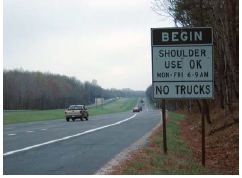
Where to Use: This treatment may be used on any HRRR without a paved shoulder.
| Add Paved Shoulder - Initial Investment: $400,000 - Cost of Maintenance: $20,000 - Frequency of Maintenance: 2 years |
Benefit-Cost Ratio | NCHRP 500 Performance Rating | Crash Modification Factor (CMF) |
|---|---|---|---|
| Lower Volume Optimal Conditions | n/a | Proven | 0.86 |
| Higher Volume Optimal Conditions | n/a | Proven | 0.86 |
| Lower Volume Narrower Conditions | 0.5 | Proven | 0.86 |
| Higher Volume Narrower Conditions | 4.5 | Proven | 0.86 |
Top Recommended Resource:
1. FHWA, Low Cost Treatments for Horizontal Curve Safety, December 2006. Available at: http://safety.fhwa.dot.gov/roadway_dept/horicurves/fhwasa07002/.
Increasing lane width on HRRR from 9- or 10-feet wide to 11- or 12-feet wide can result in up to a 50 percent reduction in crashes. Drivers on rural two-lane highways may shift closer to the center line as they become less comfortable next to a narrow shoulder. At other times, they may shift closer to the shoulder edge and are at greater risk of driving off the paved portion of the roadway as they meet oncoming traffic. Lane widening in horizontal curve sections may help agencies maximize use of the treatment while minimizing costs as opposed to widening lanes through an entire corridor.
Where to Use: This treatment may be used at locations where the width of travel lane is less than 12 feet.
| Widen Existing Travel Lanes by Two Feet or Less
per Lane - Initial Investment: $500,000 - Cost of Maintenance: $25,000 - Frequency of Maintenance: 10 years |
Benefit-Cost Ratio | NCHRP 500 Performance Rating | Crash Modification Factor (CMF) |
|---|---|---|---|
| Lower Volume Optimal Conditions | n/a | Proven | 0.95 |
| Higher Volume Optimal Conditions | n/a | Proven | 0.95 |
| Lower Volume Narrower Conditions | 0.3 | Proven | 0.95 |
| Higher Volume Narrower Conditions | 2.8 | Proven | 0.95 |
Top Recommended Resource:
1. FHWA, Mitigation Strategies for Design Exceptions, "Chapter 3. The 13 Controlling Criteria," July 2013. Available at: http://safety.fhwa.dot.gov/geometric/pubs/mitigationstrategies/chapter3/3_lanewidth.htm.
Passing or climbing lanes are auxiliary lanes that are provided in short segments to accommodate the passage of single-directional traffic.

Where to Use: This treatment can be provided where additional capacity is needed, in segment locations where head-on collisions occur as a result of passing vehicles, or locations where particularly slow moving traffic exists.
| Install Passing or Climbing Lanes - Initial Investment: $1,000,000 - Cost of Maintenance: $50,000 - Frequency of Maintenance: 10 years |
Benefit-Cost Ratio | NCHRP 500 Performance Rating |
|---|---|---|
| Lower Volume Optimal Conditions | 0.3 | Proven |
| Higher Volume Optimal Conditions | 2.3 | Proven |
| Lower Volume Narrower Conditions | 0.4 | Proven |
| Higher Volume Narrower Conditions | 3.5 | Proven |
Increasing shoulder width may offer the following benefits:
The benefits seen by increasing shoulder width vary based on before and after conditions, road classification, speed, and the presence of multiple road user types. Increasing shoulder width within horizontal curve sections may help agencies maximize use of the treatment while minimizing costs as opposed to widening shoulders along an entire corridor.
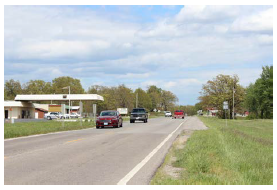
Where to Use: For narrow pavement widths, it is beneficial to provide narrower lanes with wider shoulders at low AADTs (less than 1,000 vpd), while the configuration with 12-foot lanes and no shoulders appears to be most beneficial for large AADTs (greater than 1,000 vpd).
| Safety Treatment | Initial Implementation Cost | NCHRP 500 Performance Rating | Crash Modification Factor (CMF) |
|---|---|---|---|
| Increase Shoulder Width | $100,000 and up | Proven | 0.90-0.97 |
Top Recommended Resource:
1. FHWA, Safety Evaluation of Lane and Shoulder Width Combinations on Rural, Two-Lane, Undivided Roads, June 2009. Available at: https://www.fhwa.dot.gov/publications/research/safety/09031/09031.pdf.
Superelevation is the rotation of the pavement on the approach to and through a horizontal curve and is intended to assist the driver in negotiating the curve by counteracting the lateral acceleration produced by tracking. In other words, the road is designed so that the pavement rises as it curves, offsetting the horizontal sideways momentum of the approaching vehicle.
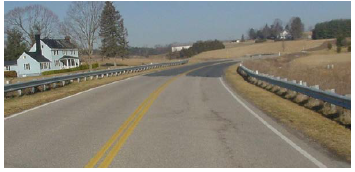
Where to Use: Superelevation is expressed as a decimal representing the ratio of the pavement slope to width, ranging from 0 to 0.12 feet. The adopted criteria allow for the use of maximum superelevation rates from 0.04 to 0.12. Maximum superelevation rates for design are established by policy by each State. Selection of a maximum superelevation rate is based on several variables, such as climate, terrain, highway location (urban vs. rural), and frequency of very slow-moving vehicles. Specific guidance on superelevation rates can be found in AASHTO's A Policy on Geometric Design of Highways and Streets and Guidelines for Geometric Design of Very Low-Volume Local Roads (ADT ≤ 400).
| Safety Treatment | Initial Implementation Cost | NCHRP 500 Performance Rating |
|---|---|---|
| Improve Superelevation at Horizontal Curve Locations | $100,000 and up | Proven |
Top Recommended Resources:
1. FHWA, Mitigating Strategies for Design Exceptions, July 2007. Available at:http://safety.fhwa.dot.gov/geometric/pubs/mitigationstrategies/.
2. AASHTO, Guidelines for Geometric Design of Very Low-Volume Local Roads (ADT ≤ 400), January 2001.
3. AASHTO, A Policy on Geometric Design of Highways and Streets, November 2011.
30 As discussed in Section 1.2, a BCR is only shown where data were available to calculate the ratio. Where data were unavailable, the BCR has been left blank. [ Return to note 30. ]
31 As stated in NCHRP Series 500 Reports (http://safety.transportation.org/guides.aspx). Proven: The safety effect for other similar applications has shown a proven benefit. Tried: The treatment has indications that it can be expected to reduce crashes, but has some conflicting reports as to its associated safety effects or has been deployed and observed to be effective. Experimental: New treatments that still need to be tested and for which the safety effect is unknown. Unknown: Not enough is known about an associated safety performance. [ Return to note 31. ]
